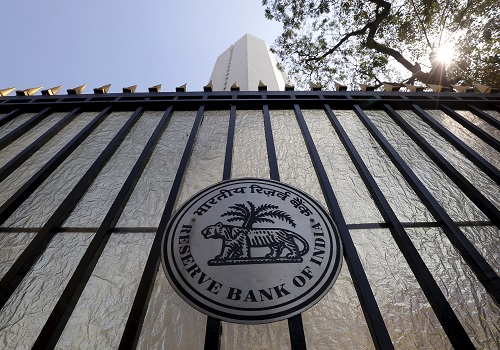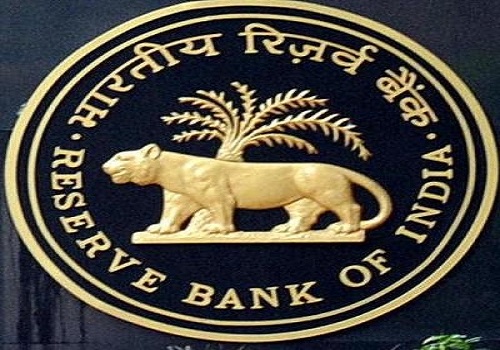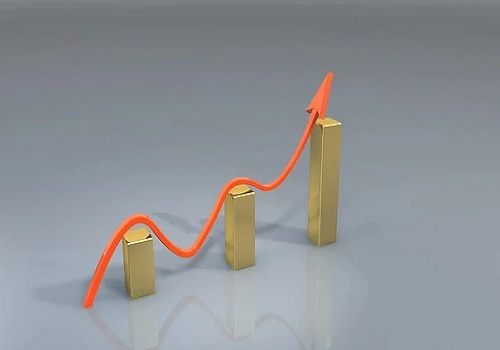Aluminium trading range for the day is 196.9-199.3 - Kedia Advisory

Follow us Now on Telegram ! Get daily 10 - 12 important updates on Business, Finance and Investment. Join our Telegram Channel
Gold
Gold faced a slight setback, closing down by -0.08% at 62249, as investors analyzed the Federal Reserve's policy stance. Federal Reserve Governor Michelle Bowman emphasized a cautious approach towards cutting U.S. interest rates, citing potential inflation risks that could impede progress. Bowman's baseline outlook anticipates a further decline in inflation with a steady policy rate, emphasizing her prudent stance on future policy changes. In February, U.S. consumer confidence retreated after three consecutive monthly increases, with the Conference Board reporting a slip in the consumer confidence index to 106.7 from a revised 110.9 in January. Consumer inflation expectations also decreased to 5.2%, the lowest since March 2020. Commerzbank's projection of Fed Funds rates falling to 4.25% by the end of 2025 aligns with the Federal Reserve's commitment to a prolonged restrictive monetary policy until more evidence surfaces regarding inflation reaching the 2% target. From a technical perspective, Gold is witnessing long liquidation, marked by a -0.82% drop in open interest to settle at 12889, accompanied by a price decline of -52 rupees. Key support levels lie at 62100 and 61945, with resistance expected at 62385 and a potential breakthrough leading to a test of 62515. The market reflects a cautious sentiment, with investors closely monitoring the Federal Reserve's stance on interest rates and seeking confirmation of a sustained decline in inflation before making significant moves in the precious metal. Traders should remain vigilant regarding these support and resistance levels for potential shifts in market dynamics.
Trading Ideas:
* Gold trading range for the day is 61945-62515.
* Gold steadied as investors continued to assess the Fed’s policy outlook.
* Fed's Bowman says she will stay 'cautious' on monetary policy
* U.S. consumer confidence retreated in February after three straight monthly increases
Silver
Silver recorded a decline of -0.41%, closing at 70770, influenced by a strengthening dollar as investors awaited crucial inflation readings in the U.S. and Europe for market direction. The new estimates of the US fourth-quarter GDP revealed a 3.2% expansion, slightly below the previous estimate of 3.3%, indicating the resilience of the U.S. economy amid restrictive interest rates. However, recent releases suggested some softening, with durable goods orders contracting sharply and new home sales rising less than expected despite downward revisions in earlier months. Market sentiment is divided on the Federal Reserve's actions, with over 60% of futures showing expectations of an interest rate cut by June. The latest CPI and payroll reports have led some market players to postpone their bets on a rate cut to the third quarter. The US trade deficit in goods widened in January 2024 to $90.20 billion, while wholesale inventories fell by 0.1% month-over-month, missing market estimates. Technically, the silver market is witnessing fresh selling, marked by a significant increase in open interest by 16.93% to settle at 26939, accompanied by a price decline of -288 rupees. Key support levels are identified at 70505 and 70245, with resistance anticipated at 71025 and a potential breakthrough leading to a test of 71285. The market appears responsive to economic data releases and inflation indicators, with investors closely monitoring the Federal Reserve's policy outlook. Traders should remain attentive to support and resistance levels for potential shifts in market dynamics.
Trading Ideas:
* Silver trading range for the day is 70245-71285.
* Silver dropped as the dollar firmed up as investors awaited key inflation readings.
* New estimates of the US fourth quarter GDP show a 3.2% expansion from the previous period
* Commerzbank downgraded its silver 2024 price targets as the Fed cuts rates less aggressively.
Crude oil
Crude oil edged up by 0.09%, settling at 6520, driven by ongoing geopolitical tensions in the Middle East, particularly ahead of the upcoming OPEC meeting. Investors are closely monitoring OPEC+'s decision in March regarding the possible extension of output cuts, with expectations that producers will continue voluntary production limits to support market stability until at least the June Ministerial Meeting. Concerns persist over uncertain ceasefire talks between Israel and Hamas, along with disruptions to Red Sea shipping by Houthi rebels in Yemen. In the U.S., crude oil stocks increased by 8.428 million barrels in the week ending February 23, marking the fourth consecutive week of rises. This follows a 7.17 million barrel jump in the previous week. However, gasoline and distillate inventories showed declines. Gasoline stocks fell by 2.8 million barrels, while distillate stockpiles, including diesel and heating oil, were down by 510,000 barrels. Technically, the crude oil market is witnessing short covering, with a -2.54% drop in open interest to settle at 6129, while prices rose by 6 rupees. Key support levels are identified at 6452 and 6383, with resistance expected at 6594 and a potential breakthrough leading to a test of 6667. The market remains sensitive to geopolitical developments and OPEC decisions, and traders should closely monitor support and resistance levels for potential shifts in market dynamics.
Trading Ideas:
* Crudeoil trading range for the day is 6383-6667.
* Crude oil rose due to ongoing geopolitical tensions in the Middle East.
* Crude inventories rose by 4.2 million barrels to 447.2 million barrels in the week ending Feb. 23.
* Gasoline stocks fell by 2.8 million barrels in the week to 244.2 million barrels, the EIA said.
Natural gas
Natural gas experienced a robust uptick, surging by 3.64% to settle at 156.7, driven by concerted efforts among producers to curb output in response to a prolonged slump in prices. Chesapeake Energy led the charge by slashing its 2024 production plans by approximately 30%, echoing similar moves by major gas producers such as Antero Resources, Comstock Resources, and EQT, all aiming to curtail drilling activities amid the challenging pricing environment. Traders grapple with a surplus of supply, elevated storage levels, and weak heating demand exacerbated by a mild winter. Despite expectations for a 64 billion cubic feet (bcf) drawdown in gas storage, US utilities pulled only 60 bcf during the week ending February 16, 2024. The decrease brought stockpiles to 2.470 trillion cubic feet (tcf), exceeding last year's levels by 265 bcf and surpassing the five-year average by 451 bcf. Technical indicators suggest short covering, as open interest dropped by -6.58% to settle at 61015, coinciding with a price increase of 5.5 rupees. Key support levels stand at 151.4 and 146.1, while resistance is anticipated at 159.7, with a potential breakthrough paving the way for testing 162.7. The natural gas market is grappling with challenges ranging from oversupply and storage concerns to weak demand, compounded by technical issues at Freeport LNG's export facility. Traders should closely monitor these support and resistance levels for potential shifts in market dynamics amid ongoing efforts to balance production and demand.
Trading Ideas:
* Naturalgas trading range for the day is 146.1-162.7.
* Natural prices rose amid efforts by producers to curb output.
* Chesapeake Energy has cut its 2024 production plans by around 30% following a sharp drop in prices to a 3-1/2 year low.
* Traders are grappling with a surplus of supply, high storage levels, and weak heating demand.
Copper
Copper faced a downturn, closing down by -0.12% at 726.05, influenced by a stronger dollar and negative developments in China's property sector. The announcement of a liquidation petition against Chinese developer Country Garden added pressure, challenging Beijing's efforts to restore confidence in a property sector that contributes significantly to China's GDP. Speculators grappled with market volatility, and copper inventories in SHFE warehouses surged to 181,323 tons, the highest since last March, indicating a slow recovery in Chinese demand since the Lunar New Year holiday. Chinese new home prices continued to decline in January despite government measures aimed at boosting confidence in the real estate sector. Investor attention shifted towards inflation data from the United States, Japan, and Europe, influencing expectations for future rate moves. The International Copper Study Group (ICSG) reported a surplus of 20,000 metric tons in the global refined copper market for December, contrasting with a deficit of 123,000 metric tons in November. However, the market still held an 87,000 metric tons deficit for the first 12 months of the year, a significant decrease from the 434,000 metric tons deficit in the same period the previous year. Technically, the copper market indicates fresh selling, with a 1.04% increase in open interest to settle at 3989, coupled with a price decline of -0.85 rupees. Key support levels are identified at 724 and 721.8, while resistance is expected at 727.5, with a potential breakthrough leading to a test of 728.8. Traders should closely monitor these levels for potential shifts in market dynamics amid ongoing global economic uncertainties.
Trading Ideas:
* Copper trading range for the day is 721.8-728.8.
* Copper fell amid stronger dollar and bad news from China's property sector.
* Chinese demand has not made much of a recovery since the Lunar New Year holiday.
* SHFE inventories than doubled in a little more than two weeks to 181,323 tons.
Zinc
Zinc faced a decline of -0.65%, settling at 213.55, influenced by the Federal Reserve's hawkish rhetoric and lower-than-expected growth in downstream consumption. The International Lead and Zinc Study Group (ILZSG) reported an increased global zinc market deficit of 62,600 metric tons in December 2023, compared to 53,500 tons in November. However, for the full year 2023, ILZSG data revealed a surplus of 204,000 tons, contrasting with a deficit of 73,000 tons in 2022. Inventories in Shanghai Futures Exchange-monitored warehouses surged by 163.80%, reflecting concerns about elevated stockpiles. China's refined zinc output in January 2024 was 567,000 metric tons, a month-on-month decrease of 4.05% and a year-on-year increase of 10.9%. Despite an increase in domestic zinc alloy output, the overall output from smelters declined due to maintenance and holiday-related shutdowns. Technically, the zinc market indicates fresh selling, with a 2.28% increase in open interest to settle at 4792, coupled with a price decline of -1.4 rupees. Key support levels are identified at 211.7 and 209.9, while resistance is expected at 214.7, with a potential breakthrough leading to a test of 215.9. The market is navigating through a complex landscape with global market deficits, increased inventories, and mixed production trends in China. Traders should closely monitor these support and resistance levels for potential shifts in market dynamics amid ongoing uncertainties in the economic environment.
Trading Ideas:
# Zinc trading range for the day is 209.9-215.9.
# Zinc dropped due to Fed's hawkish speech and the lower-than-expected increase in consumption.
# Inventories in Shanghai Futures Exchange warehouses rose by 163.80%
# China's refined zinc output in January 2024 decreased month-on-month by 4.05%
Aluminium
Aluminium experienced a marginal decline of -0.25%, settling at 198.35, influenced by the resumption of production at an aluminium smelter in Inner Mongolia after a temporary shutdown due to a power outage. The exact impact on production reduction needs confirmation, and market participants are closely monitoring developments. Downstream aluminium enterprises are gradually resuming production, contributing to short-term operating rate recovery. Seasonal inventory growth of aluminium ingots persists, albeit at a relatively low level compared to recent years. Markets continue to assess the implications of stimulus measures and a looser monetary policy in China on base metal demand. This evaluation aligns with the overall cautious sentiment driven by a pessimistic outlook for industrial demand in China, underscored by four consecutive months of contractionary manufacturing PMI amid property and financial market challenges. Aluminium stocks in Shanghai Futures Exchange-monitored warehouses surged by 65.6% last week to the highest level since May 2023, reaching 173,482 tons. China's aluminium output in January rose by 4.2% year-on-year to 3.562 million metric tons, with a daily average output of 114,900 metric tons. Technically, the aluminium market signals fresh selling, with a 2.91% increase in open interest to settle at 5240, accompanied by a price decline of -0.5 rupees. Key support levels are identified at 197.6 and 196.9, while resistance is expected at 198.8, with a potential breakthrough leading to a test of 199.3.
Trading Ideas:
* Aluminium trading range for the day is 196.9-199.3.
* Aluminium dropped as an aluminium smelter in Inner Mongolia is now resuming production
* Markets continued to assess the impact of stimulus and looser monetary policy in China on demand
* Aluminium downstream enterprises are steadily resuming production, with short-term operating rates recovering
Cotton Candy
Cotton Candy demonstrated strength in the market, settling up by 1.88% at 62820, buoyed by the prospect of tight supplies against relatively stable demand. The USDA's February WASDE report projected a reduction of 355,000 bales in the 2023/24 world cotton production, primarily due to cuts in Australia and Benin, partly offset by smaller increases elsewhere. Lower beginning stocks and production contributed to a nearly 700,000 bales reduction in world cotton ending stocks for 2023/24. Despite variations in consumption across countries, global consumption is expected to remain virtually unchanged. India's cotton exports in February are anticipated to reach the highest level in two years, driven by attractive prices making Indian cotton competitive for Asian buyers. Contracts for exporting 400,000 bales were signed in February, mainly to China, Bangladesh, and Vietnam. The rally in global prices has made Indian cotton the cheapest in the world, resulting in a surge in exports. The Cotton Association of India (CAI) predicts India's cotton production to fall by 7.7% in 2023/24, reaching the lowest level since 2007/08 at 29.41 million bales. Despite the decline in production, CAI retained its cotton pressing estimate and highlighted the potential for India to export 2 million bales in the 2023/24 marketing year, surpassing earlier expectations. Technically, the cotton candy market is undergoing short covering, with unchanged open interest settling at 477 and a price increase of 1160 rupees. Key support levels are identified at 62520 and 62210, while resistance is expected at 63320, with a potential breakthrough leading to a test of 63810.
Trading Ideas:
* Cottoncandy trading range for the day is 62210-63810.
* Cotton gains amid prospect of tight supplies against a relatively stable demand
* The projected 2023/24 world cotton production is 355,000 bales lower this month.
* World 2023/24 cotton ending stocks are nearly 700,000 bales lower compared to January
* In Rajkot, a major spot market, the price ended at 29125.5 Rupees gained by 0.97 percent.
Turmeric
Turmeric exhibited a modest uptrend, settling up by 0.41% at 16672, supported by reduced supplies in the spot market. However, the upside is limited as buying activities have been slower, anticipating the release of stocks ahead of the commencement of new crops. The delayed harvesting of new crops and tighter ending stocks are expected to keep market sentiments positive for turmeric in the near term. Export activity has been sluggish in recent months but is anticipated to increase with the upcoming series of festivals. Pressure on turmeric prices is observed due to improved crop conditions resulting from favorable weather conditions. Concerns among Maharashtra farmers have also emerged regarding PM Modi's Turmeric Board in Telangana, leading to uncertainties over the location of the board's headquarters. Turmeric exports during April-December 2023 declined by 2.27%, standing at 121,171.01 tonnes compared to 123,984.35 tonnes in the same period of 2022. However, there was a notable increase in December 2023, with 10,425.64 tonnes exported, representing a rise of 21.47% compared to November 2023.Turmeric imports during April-December 2023 dropped by 25.43%, totaling 10,655.73 tonnes compared to 14,290.11 tonnes in the same period of 2022. While there was a slight decrease in imports from November to December 2023, the year-on-year comparison showed a significant rise of 29.91%. Technically, the turmeric market is undergoing short covering, with a -0.97% drop in open interest to settle at 14230 and a price increase of 68 rupees. Key support levels are identified at 16472 and 16270, while resistance is expected at 16888, with a potential breakthrough leading to a test of 17102.
Trading Ideas:
* Turmeric trading range for the day is 16270-17102.
* Turmeric gains supported by reduced supplies in the spot market.
* However, upside seen limited as buying activities has been slower in expectation of new crops.
* Export has been slow down in recent months and expected to increase in wake of series of festivals ahead.
* In Nizamabad, a major spot market, the price ended at 14829.8 Rupees gained by 1.42 percent.
Jeera
The recent performance of the Jeera market reflects a nuanced interplay between supply-side dynamics, global demand trends, and technical indicators shaping price movements. Jeera prices registered a notable uptick of 1.02% yesterday, settling at 24365, primarily driven by low-level buying following a period of decline attributed to higher production prospects in key cultivating regions like Gujarat and Rajasthan. The current rabi season witnessed a significant expansion in Jeera acreage, with farmers in Gujarat and Rajasthan notably increasing cultivation in response to record prices observed in the previous marketing season. Gujarat, in particular, saw a remarkable 160% surge in Jeera cultivation area, surpassing normal acreage levels. Similarly, Rajasthan witnessed a 25% increase, contributing to the overall rise in production prospects. However, this surge in acreage comes with challenges such as lower water availability, fewer cold days, and concerns about crop diseases like fusarium wilt and blight. In terms of technical analysis, the market is currently experiencing short covering, evidenced by a drop in open interest by -6.69% alongside a price increase of 245 rupees. Support levels for Jeera are identified at 24040, with a potential test of 23720 levels below that. On the upside, resistance is anticipated at 24640, with a breakthrough potentially leading to a test of 24920 levels. These technical insights provide valuable guidance for traders, offering potential entry and exit points amid market fluctuations.
Trading Ideas:
* Jeera trading range for the day is 23720-24920.
* Jeera gained on low level buying after prices dropped due to higher production prospects.
* Jeera acreage hits a four-year high in the current rabi season
* Stockists are showing interest in buying on recent downfall in prices triggering short covering.
* In Unjha, a major spot market, the price ended at 27576.75 Rupees gained by 1.66 percent.
Views express by all participants are for information & academic purpose only. Kindly read disclaimer before referring below views. Click Here For Disclaimer












 320-x-100_uti_gold.jpg" alt="Advertisement">
320-x-100_uti_gold.jpg" alt="Advertisement">










